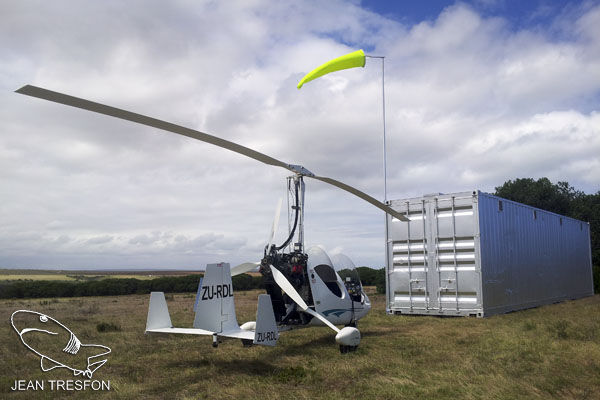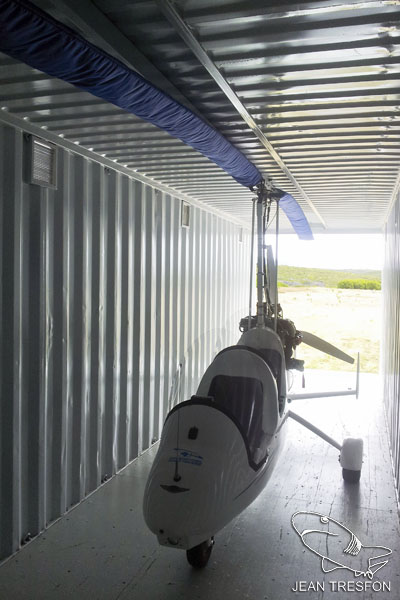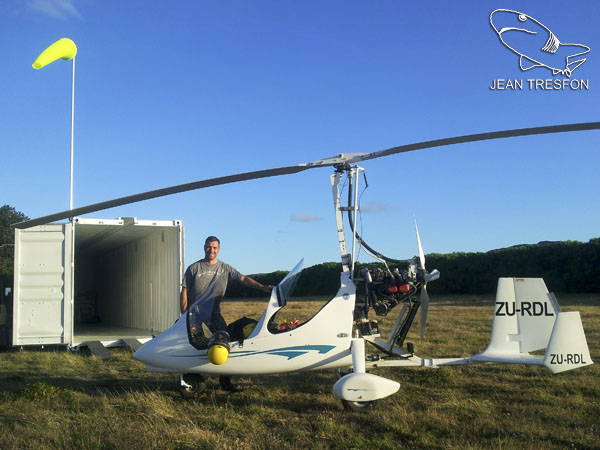I do my holiday flying from a rough & ready farm strip near the Breede River mouth. Originally the farm belonged to a pilot farmer with a massive passion for aviation, but he passed away. The runways are overgrown and only a small portion of the main runway is still usable, bad for others, great for those of us with gyros. He left the property to his 3 children (now all in their 50's) of which only one is a pilot and he no longer flies. It took me several years to get permission to use the field, and all negotiations had to include all three owners so there was plenty of back and forth. Eventually I received the go ahead after indemnities had been drawn up and signed and all the legalities were in place.
Then I made the totally audacious request to build a hangar on the property... Shock & Horror!!! Build a permanent structure on our farm??? No way!
The farm labourers and their kids live close by, there are plenty of baboons in the area and the weather can get pretty hectic in the area. No chance on God's green earth that I am going to leave my gyro parked outside with just some rainproof covers on. Imagine getting 500ft only to find that some curious kid has pulled a few wires out, or a baboon has been prancing on the rotors!
Back to the drawing board... I asked the owners if they would be amenable to a removable structure and they eventually consented. After much research I hit on the idea of using a shipping container. It's weatherproof, totally secure and pretty damn solid. So would the gyro fit inside?
The gyro has a wheelbase of 1.8m and the container is 2.4m wide so that was fine. The gyro blades span 8.5m and the container is 12m long so no problem there either. The gyro stands 2.70m high and the container stands 2.4m high... oops. Enter the "High Cube" container, which is 2.8m high. Only that was the outside measurement... The inside measurement was 2.68m. Back to the gyro to see if the actually measured height was different from the official Magni specs... I measured my gyro at 2.69m high, frustratingly out by only 1cm!!! Also the container's toprail which provides most of the structural integrity had an underside height measurement of 2.58m and the gyro needs to pass under this to get in the doors.
Off to the container guys to find out about the possibility of modifications. I dealt with Anthony Lombard at Container World who is himself a trike pilot. A more helpful and professional guy you will not find. Radical modifications were out due to big cost implications and I almost canned the idea until I chatted to Gyronaut who suggested the idea of cutting a small channel in the roof into which the rotor and rotorhead would fit. Also the toprail would need to be cut. Anthony was not happy about the idea of cutting the toprail as the container's structural integrity would be compromised. However it is designed to take 30,000kg and we would only need to put a max of around 750kg inside so it seemed it might work. After some back and forth over the design we had a drawing that looked like it might work. We designed a removable piece for the toprail which is put back when the gyro is parked back inside.
So I bought a 2nd hand high cube container and the workshop commenced with the mods. In the mean time I realised that some type of entrance ramp would be needed to get the gyro over the bottom rail and inside the container. Popped in to visit Marco Grandi at Grandi Manufacturing and only 3 days later I had myself 3 brand new shiny aluminium ramps, 2.25m long by 30cm wide and only the height was a question mark. I assumed the container would be placed on concrete slabs and had made a guess as to the finished height of the bottom rail above ground. Aluminium was used to keep the weight down as the ramps cannot be left in place or the doors will not close. They need to be put in place each time the gyro goes in or out the hangar and steel would have been much cheaper but a real back-breaker. Also the gradient cannot be too steep as one person (me) needs to be able to push the 300kg gyro up the ramp.
Next I was told by a friend that uses a container as a spares store that the temperature inside his container gets well over 70 deg celcius on a hot summer's day. Not wanting my gyro to be par-boiled I added 8 large 250mm x 250mm vents along the tops of the sides of the container. I also had it painted metallic silver to reflect as much heat as possible away. I also decided to have the inside including the floor painted white to keep as much light as possible inside the container as their is no power source on the field. Time was a constraint as it was almost holiday time and I can always add a solar panel, car battery and some LED lighting at a later stage.
Lastly I was worried that the clearance between the roof and the rotors was minimal and my rotor blades might get damaged. The standard rotor Magni rotor covers offer no padding or protection from impact, they are dust covers only. I do a lot of surfski paddling and my carbon fibre paddles have a very nice padded cover so I called up the manufacturer and between us we designed a set of padded rotor covers (which will shortly be available for sale as a standard product) which would offer some form of protection against "hangar rash".
Then all that was left to do was to buy a windsock and a flagpole, and hope all the elements would come together as everything had been designed "virtually" with not having actually having been able to get a gyro to a container and play around.
The container was duly delivered 300km to the farm. Choosing a site took a while and eventually it was placed on slabs in our preferred spot. The flagpole was erected, the container cleaned (after 80km of bad dirt road the dust was everywhere) and the ramp's height was perfect. Two days later I flew the gyro over from Bredarsdorp. The moment of truth... would it fit? Answer... like a glove. Ramps were perfect, the gyro gets inside and the covers protect the rotor against the very negligible clearance from the channel cut into the roof of the container.
I now have my totally secure and weatherproof hangar with my baby snug inside! In the event the farm owners and I ever disagree, the whole caboodle can be picked up and moved to another location.
Gyro outside with the hangar all closed up...

Gyro inside... Note the channel cut into the roof and the padded rotor covers.

Gyro outside ready to go in... Note the toprail channel removed and the entrance ramps in place.

Hope this helps anyone else with a similar predicament...
Regards
Jean.





